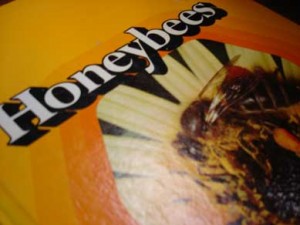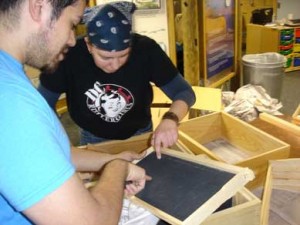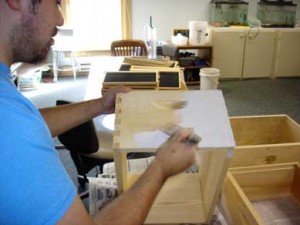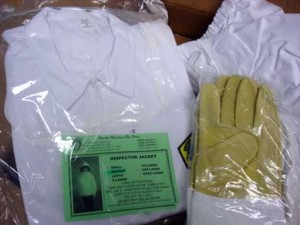
You can't be a beekeeper without doing your homework. McDonald has been reading up on bees to prepare for the new colonies.
Karen McDonald is not one to sit idly by while a fellow member of planet Earth struggles. McDonald is an educator and the Smithsonian Environmental Research Center’s outreach coordinator. This week she and Elio Cruz prepared three beehives that – come summer – will be full of the flying honey machines. Cruz is a technician at the National Museum of Natural History. He works in the museum’s O. Orkin Insect Zoo.
The three hives they assembled will eventually house around 120,000 bees. The pollinators will serve double-duty. Some will make appearances in the insect zoo. Others will become part of McDonald’s lesson plans. But the initial focus is to get the colonies established and healthy.
To that end, McDonald has scouted the area around SERC for a location that will give the bees access to plenty of pollen. She expects them to take advantage of the flowers found on tulip poplar trees, wineberry shrubs and the trumpet creeper.
McDonald began taking beekeeping classes last year. She can rattle off statistics: one bee lives about four weeks long and will create only a tablespoon or two of honey. McDonald’s struck by what the bees do and how they do it. “It amazes me that they do everything in the dark. They raise the young, pack the pollen, build the honey comb, get rid of the corpses, take care of the queen and make the honey – all in the dark confines of the hive!” She says the queen compensates for the lack of light by communicating her orders through pheromones.
Cruz will pick up the bees from local Maryland suppliers this spring. He and McDonald say not to expect honey anytime soon; the bees will need the honey they make this summer to survive the winter. But if all goes well, by August 2011, there may be some leftovers. However, Cruz notes that they won’t actually harvest it. Too bad for Smithsonian visitors and employees.





Love the blog. I’m very intrigued by the bees… Ron’s grandpa used to be a beekeeper. I look forward to following your Smithsonian adventures. -Jenn
I stronly applaud the efforts of Karen McDonald in her efforts. after reading your article it accurs to me that you shouldn’t have to find a place to close to flowering plants. The first beehives I had was in a city, and the bees had to fly at least two miles to find pollen and nectar, yet they still provided me with a very nice harvest of honey. Good luck with your beekeeping endeavor.
Do you have any video of that? I’d love to find out more details.